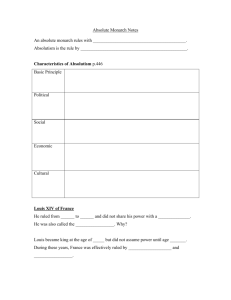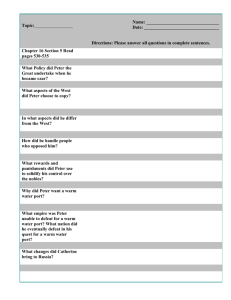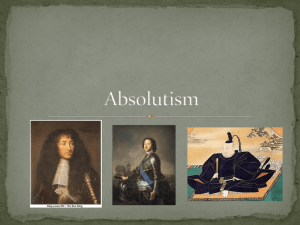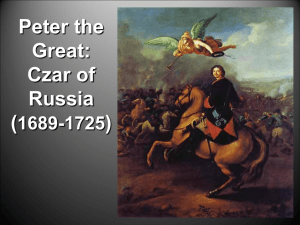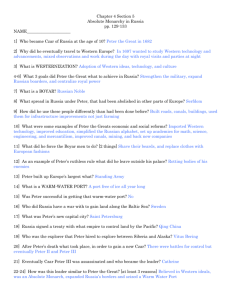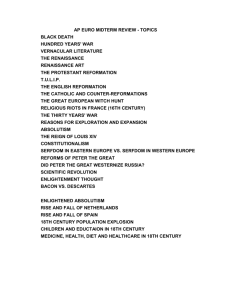Absolutism in Europe - Mater Academy Lakes High School
advertisement
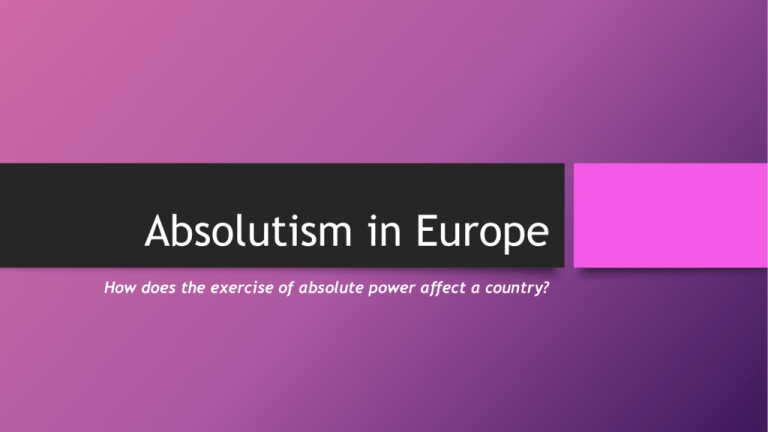
Absolutism in Europe How does the exercise of absolute power affect a country? France Under Louis XIV Guiding Question: Why is the reign of Louis XIV regarded as the best example of absolutism in the seventeenth century? • One response to the crises of the seventeenth century was to seek more stability by increasing the power of the monarch. • The result was what historians have called absolutism. • Absolutism is a system in which a ruler holds total power. • absolute monarchs supposedly received their power from God and were responsible to no one except God. • They had the ability to make laws, levy taxes, administer justice, control officials, and determine foreign policy. • The reign of Louis XIV has long been regarded as the best example of absolutism in the seventeenth century. The Spread of Absolutism in Europe Guiding Question: How did Prussia and Austria emerge as great powers in seventeenth- and eighteenth-century Europe? • Although absolutism largely failed in Spain, it was more successful in central and eastern Europe. Quick - Let’s recap Spain’s problems from the last class notes: 1: Economy? 2: Spanish Armada • With Spain out as a world super power - Prussia and Austria emerged in the seventeenth and eighteenth centuries as two great European powers. Prussia: Present day Germany included parts of present-day Germany, Poland, Russia, Lithuania, Denmark, Belgium and the Czech Republic. The Emergence of Prussia Frederick William the Great Elector laid the foundation for the Prussian state. • Realizing that Prussia was a small, open territory with no natural frontiers for defense, Frederick William built a large and efficient standing army. • He had a force of 40,000 men, which made the Prussian army the fourth-largest in Europe. • To maintain the army and his own power, Frederick William set up the General War Commissariat to levy taxes for the army and oversee its growth. • The Commissariat soon became an agency for civil government as well. • The new bureaucratic machine became the elector’s chief instrument to govern the state. • Many of its officials were members of the Prussian landed aristocracy, or the Junkers, who also served as officers in the army. In 1701, Frederick William’s son Frederick officially gained the title of king. Elector Frederick III became King Frederick I. The New Austrian Empire In the seventeenth century the Hapsburgs created a new empire in eastern and southeastern Europe. • The core of the new Austrian Empire was the traditional Austrian lands in present-day Austria, the Czech Republic, and Hungary. • Austria then took control of all of Hungary, Transylvania, Croatia, and Slavonia. • By the beginning of the eighteenth century, the Austrian Hapsburgs had gained a sizable new empire. • The Austrian monarchy, however, never became a highly centralized, absolutist state, chiefly because it was made of so many different national groups. • The Austrian Empire remained a collection of territories held together by the Hapsburg emperor, who was archduke of Austria, king of Bohemia, and king of Hungary. • Each of these areas had its own laws and political life. • No common sentiment tied the regions together other than the ideal of service to the Hapsburgs. • Hapsburgs = Austrian Empire Peter the Great Guiding Question: How did Russia emerge as a powerful state under Peter the Great? A new Russian state emerged in the fifteenth century and In the sixteenth century, Ivan IV became the first ruler to take the title of czar, the Russian word for caesar. • Ivan expanded the territories of Russia eastward. • He also crushed the power of the Russian nobility, or boyars. • He was known as Ivan the Terrible because of his ruthless deeds, including stabbing his son to death in a heated argument. • When Ivan’s dynasty ended in 1598, a period of anarchy, the Time of Troubles, followed. Anarchy: a state of disorder due to absence or non-recognition of authority. Peter the Great - became czar in 1689. • Peter was an absolute monarch who claimed the divine right to rule. • After becoming czar, Peter visited the West. Determined to westernize Russia, he was eager to borrow European technology. • Modernization of the army and navy was crucial to make Russia a great power. • Peter employed Russians and Europeans as officers. • He drafted peasants for 25-year stints of service to build a standing army of 210,000 soldiers. • By Peter’s death in 1725, Russia was a great military power and an important European state. • • • • Peter began to introduce Western customs, practices, and manners into Russia. He ordered the first Russian book of etiquette to teach Western manners. Men had to shave their beards and shorten their coats. Upper class women were allowed to remove their traditional face-covering veils. • STOP – WHAT DO WE MEAN BY WESTERN VALUES? • -Originating in Europe Along with making Russia into a great state and military power, Peter wanted to open a “window to the West,” meaning a port with ready access to Europe. • This could be achieved only on the Baltic Sea, which Sweden, the most important power in northern Europe, controlled. • Peter acquired the lands he sought after a long war with Sweden. • On the Baltic in 1703, Peter began construction of a new city, St. Petersburg, a base for the new Russian navy and a window to the West. • St. Petersburg became Russia’s most important port and remained the Russian capital until 1918. To impose the rule of the central government more effectively, Peter divided Russia into provinces. • He hoped to create a “police state,” a well ordered community governed by law. • However, few bureaucrats shared his concept of honest service and duty to the state. • Peter’s personality created an atmosphere of fear. He wrote to one administrator, “According to these orders act, act, act. I won’t write more, but you will pay with your head if you interpret orders again.” Peter wanted the impossible—that his administrators be slaves and free persons at the same time. -What does this mean?
